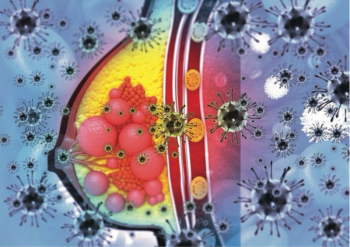
- ONCOLOGY Vol 11 No 4
- Volume 11
- Issue 4
Paclitaxel as First-Line Treatment for Metastatic Breast Cancer
When administered as a single agent in pretreated patients with advanced breast cancer, paclitaxel (Taxol) exhibits remarkable antitumor activity. This trial was undertaken to compare paclitaxel with standard
ABSTRACT: When administered as a single agent inpretreated patients with advanced breast cancer, paclitaxel (Taxol) exhibitsremarkable antitumor activity. This trial was undertaken to compare paclitaxelwith standard chemotherapy as front-line therapy for this disease. Patientswith measurable or evaluable metastatic breast cancer, no prior chemotherapyfor metastatic disease, and an Eastern Cooperative Oncology Group performancestatus of 0 to 2 were randomized to receive paclitaxel 200 mg/m² intravenouslyover 3 hours for eight cycles (6 months) or standard treatment with oralcyclophosphamide (Cytoxan) 100 mg/m²/d days 1 through 14, intravenousmethotrexate 40 mg/m² days 1 and 8, intravenous 5-fluorouracil 600mg/m² days 1 and 8, and oral prednisolone 40 mg/m²/d (CMFP) days1 through 14 for six cycles (6 months). Patients whose disease progressedor relapsed were recommended to receive second-line epirubicin. Accrualhas been completed with 208 patients randomized, but a preplanned interimanalysis of the first 100 patients is reported here. Analysis of qualityof life, assessed by a linear analogue scale and overall quality of lifeindices, is ongoing. Objective response occurred in 31% (confidence interval,19% to 45%) with paclitaxel and 35% (confidence interval, 22% to 51%) withCMFP with stable disease in an additional 33% and 29%, respectively. Mediantime to progression was 5.5 months for paclitaxel-treated patients and6.4 months for those given CMFP, with median survival durations of 17.3and 11.3 months, respectively. Grades 3 and 4 neutropenia occurred in 64%of patients treated with paclitaxel and in 63% treated with CMFP. However,febrile neutropenia was the primary reason for hospitalization in 1% ofpaclitaxel courses, compared with 8% of CMFP courses. Nine percent of thepatients had major infections with CMFP, but none were seen with paclitaxel.Moderate or severe mucositis occurred in 13% of paclitaxel-treated and27% of CMFP-treated patients. Alopecia and peripheral neuropathy were morecommon with paclitaxel. Quality of life assessments in the first 100 patientssuggest better overall results on paclitaxel treatment as compared withCMFP. Preliminary analyses suggest that single-agent paclitaxel is welltolerated and provides comparable control of metastatic cancer to CMFPcombination therapy when used as front-line treatment. [ONCOLOGY 11(Suppl):19-23,1997]
In the United States each year, more than 180,000 women are diagnosedwith breast cancer and more than 45,000 die of the disease each year.[1]In spite of major advances in adjuvant therapy, metastatic breast cancerremains a major clinical problem affecting large numbers of patients.
For many years, standard-dose combination chemotherapy has been themainstay of therapy for metastatic disease that is hormone resistant, estrogen-receptornegative, or associated with life-threatening or visceral disease. Thechoice of initial chemotherapy has been combination cyclophosphamide (Cytoxan)/methotrexate/5-fluorouracil(5-FU) (CMF) or CMF with prednisone (CMFP), with or without vincristine(Oncovin) followed by anthracycline, or doxorubicin (Adriamycin)-containingcombinations.[2-4] The choice of initial chemotherapy is often complicatedby early relapse in patients who have received adjuvant chemotherapy.
When first described by Cooper,[5] the CMF combination was reportedto induce high response rates. Modern criteria and increasingly sophisticatedimaging procedures for assessment of the extent of disease and responsehave shown that the CMF regimen, with or without vincristine and prednisolone,produces objective responses in about 37% to 59% of patients (Table1).[2,6-14] Perhaps more significant, median response duration rangesfrom 6 to 11 months, and the median survival from initiation of treatmentranges from 7 to 16 months.
CMF Combinations and Doxorubicin
Doxorubicin alone has been shown to be as active as CMF in randomizedstudies of patients with advanced breast cancer.[2,8,15,16] In these studies,single-agent doxorubicin produced shorter response durations than CMF,but there was no obvious difference in survival. Survival was difficultto interpret, however, because patients were often crossed over to thealternative regimen on progression.
Six randomized studies of cyclophosphamide/doxorubicin/5-FU (CAF) versusCMF in advanced breast cancer have been reviewed by Henderson.[17-23] Threeof the six showed significantly higher response rates with the CAF combination,but only two of six showed a statistically significant survival advantagefor the doxorubicin combination.
These studies have been interpreted as showing a slight advantage fordoxorubicin combinations in treatment of metastatic breast cancer.[17]This interpretation is controversial, and any improvement in outcome withstandard-dose doxorubicin combinations compared to CMF is likely to bemarginal.
An Australian randomized study compared doxorubicin/cyclophosphamide (AC) with CMFP in 305 previously untreated patients with metastaticbreast cancer.[12] The response, response duration, and survival were similarwith either CMFP or AC given continuously until relapse. There also wasno difference in the effect of either regimen on life-threatening or visceraldisease. The doxorubicin combination was associated with significantlymore nausea, vomiting, and alopecia than was the CMFP combination. A quality-of-lifeassessment by patients on this study revealed that the parameter measuringnausea and vomiting deteriorated for patients on AC, but not for thoseon CMFP.
This Australian trial provided a rationale for the use of CMFP as thecontrol arm of a phase III randomized trial of CMFP versus paclitaxel (Taxol).
Paclitaxel is a novel cytotoxic agent that binds to the beta-tubulinmonomer, inducing permanent microtubular polymerization.[24,25] The resultingloss of dynamic reorganization of microtubules during mitosis results inselective blockade of the G2/M phase of cell division. Thisaction in vitro correlates with clinical activity of paclitaxel.[26]
Paclitaxel, given as a 24-hour infusion, has been found to be activein previously treated patients with advanced breast cancer.[27] In a single-institutionstudy conducted at the M.D. Anderson Cancer Center, Holmes reported 6 of11 previously treated patients responded to paclitaxel therapy with similarresponses seen in 8 of 14 patients who had prior adjuvant chemotherapyonly.[27] Of six patients who were resistant to doxorubicin, two achieveda partial remission in response to paclitaxel. Since this initial reportthere have been a number of studies and reviews confirming that paclitaxelis active in previously treated and anthracycline-resistant breast cancer.[28-32]The reported response rates have been quite variable, however, rangingfrom 20% to 62% with similar variability in response duration.
The schedule of paclitaxel infusion also has varied, with most of theearlier studies using 24-hour infusions. Other studies have since reported1-hour and 3-hour infusion times.[33-35] A large, randomized European-Canadianstudy compared two doses of paclitaxel (135 mg/m² vs 175 mg/m²)and two infusion times (3-hour vs 24-hour) in patients with relapsed ovariancancer. In these ovarian cancer patients, there were no differences relatedto the two infusion rates. The incidence of hypersensitivity reactionswas low and also was not influenced by dose or schedule. However, thisstudy clearly demonstrated that the 24-hour paclitaxel infusion is associatedwith a significantly greater reduction in neutrophils following each coursecompared to the 3-hour infusion.[33] This observation has been confirmedby a recent randomized study comparing 3-, 6-, and 96-hour infusions ofpaclitaxel.[36] Greco and Hainsworth[35] showed that 1-hour paclitaxelinfusions were safe, with the dose-limiting toxicity remaining leukopenia,as expected.[35] Although numbers were small, approximately 35% of previouslytreated patients with breast cancer responded to the 1-hour paclitaxelregimen, at a dose of 135 mg/m². According to these data, there isno compelling evidence that longer infusion times are associated with increased efficacy, at least in ovarian cancer. Those data and the convenienceof the shorter administration schedule have provided a rationale for explorationof shorter infusion times for the treatment of breast cancer.
We have reported the preliminary results of a phase III randomized trialof CMFP versus paclitaxel in previously untreated patients with metastaticbreast cancer.[37] Patients eligible for this study had measurable or evaluablemetastatic breast cancer and had had no prior chemotherapy, except foradjuvant chemotherapy, for at least 6 months prior to study entry. No priorradiotherapy was permitted for at least 4 weeks prior to study entry. Patientswere required to have Eastern Cooperative Oncology Group performance statusof 0 to 2, adequate bone marrow function, liver function, and renal function.Responses and toxicity were evaluated using the criteria of the World HealthOrganization (WHO),[38] and patients were required to give written informedconsent prior to enrollment.
Eligible patients were randomized to either paclitaxel or CMFP. Paclitaxel200 mg/m² was given as a 3-hour continuous intravenous (IV) infusionevery 21 days for a total of 8 courses over 24 weeks. Standard premedicationincluded dexamethasone 20 mg orally (PO) 12 and 6 hours prior to therapy,and diphenhydramine 50 mg IV and cimetidine 300 mg IV 30 minutes priorto paclitaxel. Standard antiemetics including metoclopramide, prochlorperazine,ondansetron, and dexamethasone were given if required.
CMFP chemotherapy was given as cyclophosphamide 100 mg/m² PO dailyon days 1 to 14, methotrexate 40 mg/m² IV on days 1 and 8, 5-FU 600mg/m² IV on days 1 and 8, and prednisone 40 mg/m² PO daily days1 to 14. This schedule was repeated every 4 weeks for six courses, over24 weeks. Antiemetics were given as for the paclitaxel treatment arm. Uponcompletion of 6 months of therapy, chemotherapy was stopped and patientswere observed until relapse.
Appropriate clinical assessment and imaging techniques for tumor evaluationwere carried out at baseline and at 12 and 24 weeks unless the patientprogressed clinically before that time. The routine assessments includedquality-of-life evaluations previously used and reported by this groupof investigators.[12] Patients whose disease progressed were recommendedfor subsequent treatment with single-agent epirubicin.
Results
Accrual to this trial is complete at 208 patients, but preliminary analysisis only available for the first 100 patients (55 treated with paclitaxeland 45 with CMFP).[37] No formal comparative analysis will be performedon the first 100 patients. Objective responses were attained by 31% (95%confidence interval [CI], 19% to 45%) of patients in the paclitaxel-treatmentgroup and 36% (95% CI, 22% to 51%) of those given CMFP. An additional 33%of patients on the paclitaxel arm and 29% of those on the CMFP arm had stable disease. By the time of thisreport, disease progression had occurred in 89% of paclitaxel-treated patientsand 91% of CMFP-treated patients. The median progression-free survivalwas 5.5 months (95% CI, 4.1 to 5.7 months) in the paclitaxel arm and 6.4months (95% CI, 4.1 to 7.6 months) in the CMFP arm. At the time of thepreliminary report, the median survival was 17.3 months (95% CI, 13.2 to24.7 months) for paclitaxel-treated patients and 11.3 months (95% CI, 9.2to 15.3 months) for CMFP-treated patients. Of those first 100 cases, 65%of the paclitaxel group and 47% of the CMFP group were alive at 12 months.
Toxicity comparisons revealed that WHO grade 3 and 4 neutropenia developedin 64% of patients treated with paclitaxel and 63% with CMFP (Table2). There were 2% WHO grade 2 to 4 infections with paclitaxel and 14%with CMFP. Hospital admissions were required for febrile neutropenia intwo of 332 (1%) courses of paclitaxel and 15 of 184 (8%) courses of CMFP.There were 13% of paclitaxel patients with WHO grade 2 to 3 mucositis and27% with CMFP. WHO grade 3 peripheral neuropathy was seen in 5% of paclitaxelpatients with grade 2 in 35% compared to no grade 2 or 3 peripheral neuropathyon CMFP. Although 36% of paclitaxel patients experienced mild hypersensitivityreactions, none had severe reactions, and there were no reactions withCMFP. In 58% of paclitaxel patients WHO grade 2 to 3 myalgia or arthralgiadeveloped, compared to 7% of CMFP patients.
Quality of life was assessed by the patient using a linear analoguescale[12] and by the physician. The change in quality of life with treatmentcompared to baseline values suggested that paclitaxel-treated patients,overall, maintained or improved their quality of life, while CMFP-treatedpatients experienced a deterioration in their quality of life (Table3).
Further follow-up of all 208 patients accrued to this study is requiredbefore the final results are known and can be reported. However, the investigatorsconcluded that these preliminary results suggest that single-agent paclitaxel,used as initial chemotherapy in an outpatient setting, was well toleratedand effected comparable control of metastatic cancer in comparison to standardCMFP therapy. Preliminary quality-of-life assessment in the first 100 patientsstudied revealed that quality of life may have improved with paclitaxelbut appeared to decline with the CMFP regimen.
Paclitaxel is clearly an active drug for treatment of metastatic breastcancer and represents an important addition to other chemotherapy agents.Its place as a single agent in the first-line treatment of metastatic breastcancer will be determined by randomized studies such as this one and others comparing paclitaxel to anthracycline-containingregimens. Preliminary results are encouraging and suggest that front-linepaclitaxel may produce similar antitumor control with improved qualityof life compared to CMFP.
Ultimately, however, paclitaxel is likely to be used in combinationwith other chemotherapy drugs. Particularly exciting phase II studies ofcombination paclitaxel/doxorubicin have reported responses from 58% to94%. These studies suggest that an important future role for paclitaxelwill be in combination with anthracyclines.[39,40] In the study by Gianniand colleagues,[40] a maximum tolerated dose of paclitaxel 200 mg/m²was established, with doxorubicin given at fixed dose of 60 mg/m².In that study, dose-limiting toxicities were neutropenia and mucositis.Six women had reversible congestive heart failure after a median totaldoxorubicin dose of 480 mg/m². Complete responses were seen in 41%of patients, for a total objective response of 94%. This response ratecompares with a complete response rate of 15% reported in most studiesof combination chemotherapy for metastatic breast cancer.[12,17,23] Themedian response duration in the study by Gianni and colleagues[40] was8 months for complete responders and 11 months for partial responders.Caution may be needed in patient selection, scheduling, and monitoringto avoid cardiac or other side effects with this combination. Subsequentstudies by Gianni and colleagues[41,42] showed that six courses of thesame combination resulted in similar efficacy but a major reduction incardiotoxicity.
Combination paclitaxel/doxorubicin is now the subject of a large, randomizedIntergroup study in the United States comparing single-agent doxorubicin(60 mg/m²), single-agent paclitaxel (175 mg/m²), and doxorubicin(50 mg/m²) plus paclitaxel (150 mg/m²); it is also the subjectof other studies.[43] The Southwest Oncology Group (SWOG) is randomizingpatients to doxorubicin 60 mg/m2 and paclitaxel 200 mg/m²compared with AC. The European Organization for the Research and Treatmentof Cancer is studying doxorubicin 60 mg/m² and paclitaxel 175 mg/m²compared with AC. If the high response rates previously reported are confirmedin these trials and translate into a meaningful survival advantage in alarge cooperative-group setting, paclitaxel will have made another importantcontribution to the treatment of breast cancer.
References:
1. American Cancer Society: Cancer statistics. CA Cancer J Clin42:30-31, 1992.
2. Brambilla C, DeLena M, Rossi A, et al: Response and survival in advancedbreast cancer after two non-cross-resistant combinations. Br MedJ 1:801-804, 1976.
3. Canellos GP, Pocock S, Taylor S, et al: Combination chemotherapyfor metastatic breast carcinoma. Cancer 38:1882-1886, 1976.
4. Tranum B, Hoogstraten B, Kennedy A, et al: Adriamycin in combinationfor the treatment of breast cancer. Cancer 41:2078-2083, 1978.
5. Cooper RG: Combination chemotherapy in hormone-resistant breast cancer(abstract). Proc Am Assoc Cancer Res 10:15, 1967.
6. Muss HB, White DR, Cooper R, et al: Combination chemotherapy in advancedbreast cancer. A randomised trial comparing a three vs a five-drug program.Arch Intern Med 137:1711-1714, 1977.
7. Smalley RV, Murphy S, Huguley CM, et al: Combination versus sequentialfive-drug chemotherapy in metastatic carcinoma of the breast. CancerRes 36:3911-3916, 1976.
8. Hoogstraten B, George SL, Samal B, et al: Combination chemotherapyand Adriamycin in patients with advanced breast cancer. Cancer 38:13-20,1976.
9. Cebon JS, Bishop JF, Harvey V, et al: Dose intense weekly cyclophosphamide,methotrexate, 5-fluorouracil, vincristine and prednisolone (CMFP) in advancedbreast cancer. Br J Cancer 61:133-136, 1990.
10. Canellos GP, DeVita V, Gold GL, et al: Combination chemotherapyfor advanced breast cancer: Response and effect on survival. Ann InternMed 84:389-392, 1976.
11. Cummings FJ, Gelman R, Horton J: Comparison of CAF versus CMFP inmetastatic breast cancer: Analysis of prognostic factors. J Clin Oncol3:932-940, 1985.
12. Coates A, Gebski V, Bishop JF, et al: Optimizing quality of lifeduring chemotherapy for advanced breast cancer: A comparison of intermittentand continuous treatment strategies. N Engl J Med 317:1490-1495,1987.
13. Aisner J, Weinberg V, Perloff M, et al: Chemotherapy vs chemoimmunotherapy(CAF vs CAFVP vs CMF each +/- MER) for metastatic carcinoma of the breast.J Clin Oncol 5:1523-1533, 1987.
14. Creech R, Catalano RB, Mastrangelo MJ, et al: An effective low-doseintermittent cyclophosphamide, methotrexate, and 5-fluorouracil treatmentregimen for metastatic breast cancer. Cancer 35:1101-1107, 1975.
15. Carbone PP, Bauer M, Band P, et al: Chemotherapy of disseminatedbreast cancer. Cancer 39:2916-2922, 1977.
16. Tormey DC, Gelman R, Band PR, et al: Comparison of induction chemotherapiesfor metastatic breast cancer. Cancer 50:1235-1244, 1982.
17. Henderson IC: Principles in the management of metastatic disease,in Harris JR, Hellman S, Henderson IC, et al (eds): Breast Diseases,pp 604-673. Philadelphia, Lippincott, 1992.
18. Bull J, Tormey D, Li SH, et al: A randomized comparative trial ofAdriamycin versus methotrexate in combination drug therapy. Cancer 41:1649-1657,1978.
19. Muss HB, White DR, Richards F III, et al: Adriamycin versus methotrexatein five-drug combination chemotherapy for advanced breast cancer. Cancer42:2141-2148, 1978.
20. Bezwoda WR, de Moor NG, Derman D, et al: Combination chemotherapyof metastatic breast cancer. Cancer 44:392-397, 1979.
21. Tormey DC, Weinberg VE, Holland JF, et al: A randomized trial offive and three drug chemotherapy and chemoimmunotherapy in women with operablenode positive breast cancer. J Clin Oncol 1:138-145, 1983.
22. Brincker H, Rose C, von der Maase H, et al: A randomized study ofCAF + TAM (tamoxifen) versus CMF + TAM in metastatic breast cancer (abstract).Proc Am Soc Clin Oncol 3:113, 1984.
23. Tormey DC, Weinberg VE, Leone LA, et al: A comparison of intermittentvs continuous and of Adriamycin vs methotrexate 5-drug chemotherapy foradvanced breast cancer. Am J Clin Oncol 7:231-239, 1984.
24. Horwitz SB: Mechanism of action of Taxol. Trends Pharmacol Sci13:134-136, 1992.
25. Rao S, Horwitz SB, Ringel I: Direct photoaffinity labelling of tubulinwith Taxol. J Natl Cancer Inst 84:785-788, 1992.
26. Rowinsky EK, Burke PJ, Karp JE, et al: Phase I and pharmacodynamicstudy of Taxol in refractory acute leukemias. Cancer Res 49:4640-4647,1989.
27. Holmes FA, Walters RS, Theriault RL, et al: Phase II trial of Taxol,an active drug in treatment of metastatic breast cancer. J Natl CancerInst 83:1797-1805, 1991.
28. O'Shaughnessy JA, Cowan KH: Current status of paclitaxel in thetreatment of breast cancer. Breast Cancer Res Treat 33:27-37, 1994.
29. Seidman AD, Reichman BS, Crown JPA, et al: Paclitaxel as secondand subsequent therapy for metastatic breast cancer: Activity independentof prior anthracycline response. J Clin Oncol 13:1152-1159, 1995.
30. Gianni L, Capri G, Munzone E, et al: Paclitaxel efficacy in patientswith advanced breast cancer resistant to anthracyclines. Semin Oncol 21(suppl 8):29-33,1994.
31. Wilson WH, Berg SL, Bryant G, et al: Paclitaxel in doxorubicin-refractoryor mitoxantrone-refractory breast cancer: A phase I/II trial of 96-hourinfusion. J Clin Oncol 12:1621-1629, 1994.
32. Gelmon K, Nabholtz JM, Bontenbal M: Randomized trial of two dosesof paclitaxel in metastatic breast cancer after failure of standard therapy(abstract 493). Ann Oncol 5(suppl 5):198, 1994.
33. Eisenhauer EA, ten Bokkel Huinink WW, Swenerton KD, et al: European-Canadianrandomized trial of paclitaxel in relapsed ovarian cancer: High-dose versuslow-dose and long versus short infusion. J Clin Oncol 12:2654-2666,1994.
34. Schiller JH, Storer B, Tutsch K, et al: A phase I trial of 3 hourinfusions of paclitaxel with or without granulocyte colony-stimulatingfactor. Semin Oncol 21(suppl 8):9-14, 1994.
35. Greco AP, Hainsworth JD: One hour paclitaxel infusion schedules:A 1-hour infusion schedule. Semin Oncol 22(suppl 6):118-123, 1995.
36. Rischin D, Millward M, Toner GC, et al: Cremophor levels in patientsreceiving 3, 6 and 96 hour infusions of paclitaxel. J Natl Cancer Inst1996 (in press).
37. Bishop JF, Dewar J, Tattersall MH, et al: A randomized phase IIIstudy of Taxol (paclitaxel) vs CMFP in untreated patients with metastaticbreast cancer (abstract). Proc Am Soc Clin Oncol 15:110, 1996.
38. Miller AB, Hoogstraten B, Staquet M, et al: Reporting results ofcancer treatment. Cancer 47:207-214, 1981.
39. Sledge GW, Robert N, Sparano JA, et al: Eastern Cooperative OncologyGroup studies of paclitaxel and doxorubicin in advanced breast cancer.Semin Oncol 22(suppl 6):105-108, 1995.
40. Gianni L, Munzone E, Capri G, et al: Paclitaxel by 3-hour infusionin combination with bolus doxorubicin in women with untreated metastaticbreast cancer: High antitumor efficacy and cardiac effects in a dose-findingand sequence-finding study. J Clin Oncol 13:2688-2699, 1995.
41. Gianni L, Demicheli R, Moliterni A, et al: Pilot study of primarychemotherapy with doxorubicin/paclitaxel (AT) in women with T2-T3 or locallyadvanced breast carcinoma (abstract). Proc Am Soc Clin Oncol 15:A129,1996.
42. Gianni L, Capri G, Tarenzi E, et al: Efficacy and cardiac effectsof 3-hr paclitaxel (P) plus bolus doxorubicin (DOX) in women with untreatedmetastatic breast carcinoma (abstract). Proc Am Soc Clin Oncol 15:A128,1996.
43. Gehl P, Goesgaard N, Paaske L, et al: Combined doxorubicin and paclitaxelin advanced breast cancer: Effective and cardiotoxic. Ann Oncol7:687-693, 1996.
Articles in this issue
over 28 years ago
Book Review: Physicians' Guide to the Internetover 28 years ago
Study of Protein Blocking Normal Cell Death May Improve Cancer Drugsover 28 years ago
An Overview of Adenocarcinoma of the Small Intestineover 28 years ago
Roswell Park to Administer "Old" Drug in a New Wayover 28 years ago
NY Lt. Governor Calls for a Halt to HMO AbusesNewsletter
Stay up to date on recent advances in the multidisciplinary approach to cancer.

















































































